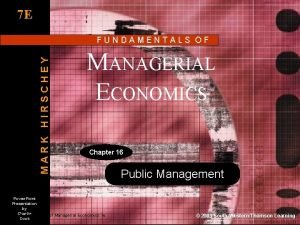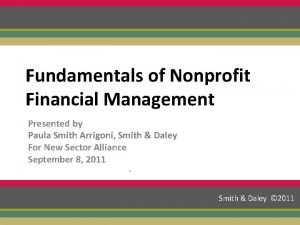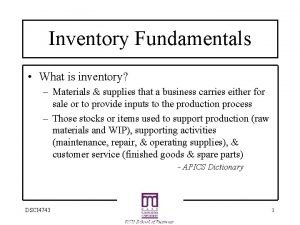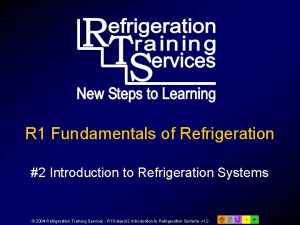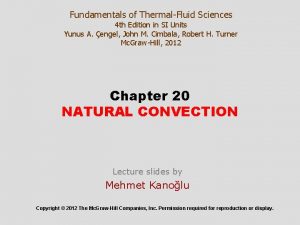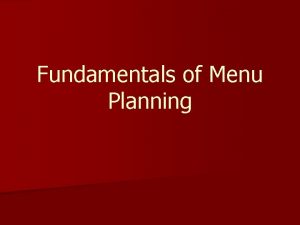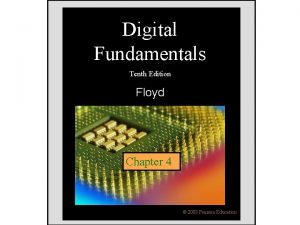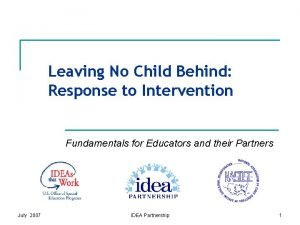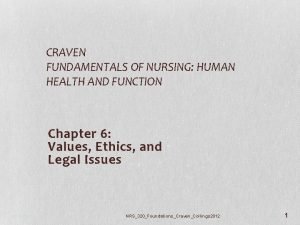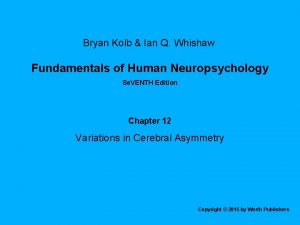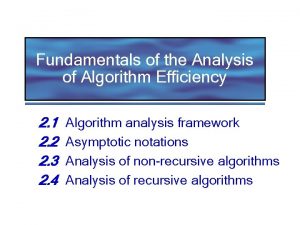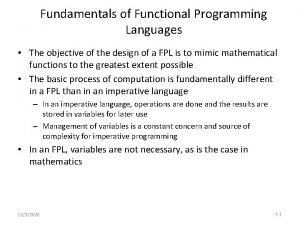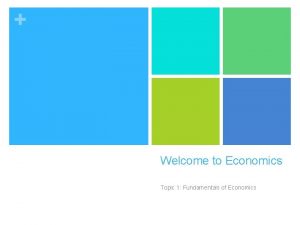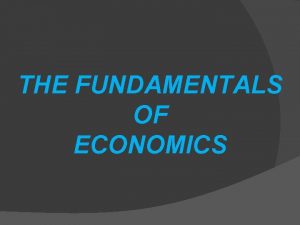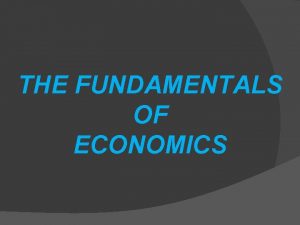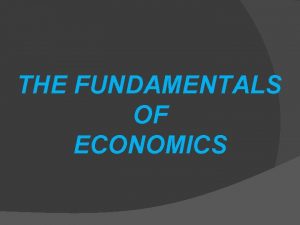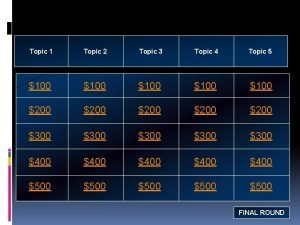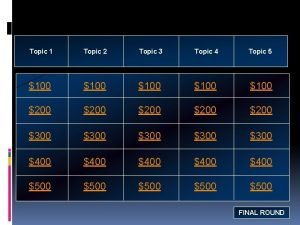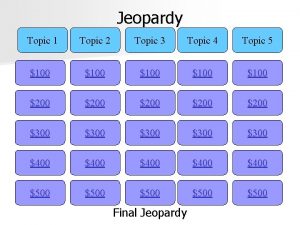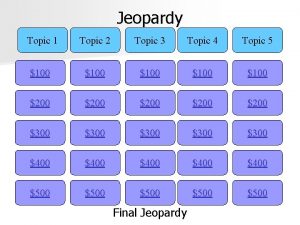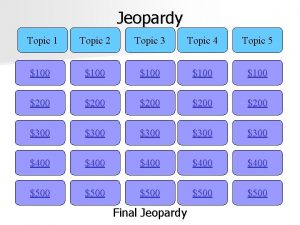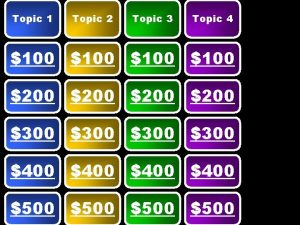Welcome to Economics Topic 1 Fundamentals of Economics




















- Slides: 20

+ Welcome to Economics Topic 1: Fundamentals of Economics

+ Topic Objectives Students will be able to n Explain why scarcity and choice are the basis of economics in every society. n Describe three economic factors of production and the differences b/w physical and human capital. n Explain how scarcity affects the factors of production n Identify why every decision involves basic trade-offs n Explain the concept of opportunity cost. n Describe how people make decisions by thinking at the margin. n Interpret a production possibilities curve.

+ What is Economics? n Economics- the study of how individuals, businesses and governments make choices when faced with a limited supply of resources

+ Scarcity and it’s impact on economics n Scarcity forces us to make choices, we cannot have everything n Needs n Wants

+ Businesses have goods and services n There is no way to solve the scarcity problem n Businesses provide either goods or services

+ Entrepreneurs Impact on Economics n Entrepreneurs are people who decide how to combine resources to create new goods and services n Entrepreneurs have different tasks: n Factors of production- resources needed/used to make all goods and services n Land n Labor n Capital n Physical capital n Human capital

+ Section 2: Opportunity Cost and Trade-Offs

+ What is an Opportunity Cost? n Opportunity Cost- the most desirable alternative somebody gives up as the result of a decision n Example: Going to Sports Night practice or going to a teacher’s extra help- which would be the best decision for you?

+ What is a trade-off? n A trade off is the act of giving up on one benefit to gain another, greater benefit n Usually involve things that can be easily measured, such as money, property, or time n Can also include things that cannot be easily measured n Can be applied to individuals and businesses n Guns or butter- describes one of the common choices facing government: the choice between spending money on military or domestic needs

+ Thinking at the Margin n Thinking at the margin: the process of deciding how much more or less to do n People have to decide the opportunity costs and benefits n Thinking at the margin applies to not only businesses but also to individuals and government n Example: Legislatures think at the margin when deciding how much to increase spending on a government program n Decision makers have to compare the opportunity costs and benefits: what will sacrifice and what will gain n Decision making process is sometimes called cost/benefit analysis

+ Cost/benefit analysis n Cost/benefit analysis is the examination of what will be sacrificed and what will be gained n A decision making process in which you compare what you will sacrifice and gain by a specific action. n Marginal cost- the extra cost of adding one unit n Marginal benefit- the extra benefit of adding the same unit n **As long as the marginal benefit exceed the marginal cost, it pays to add more units



+ Section 3: The Production Possibilities Curve n The Production Possibilities Curve is used to decide what and how much to produce n It is a graph that shows alternative ways to use an economy’s productive resources n The graph can show effective an economy is, whether an economy is growing and the opportunity cost of producing more of one good or service



+ Production Possibilities Frontier n Production Possibilities Frontier is a line in the production possibilities curve that combines the production of two different products n Each point on the production possibilities curve frontier reflects a trade-off n These trade-offs are necessary because factors of production are scarce n Using land, labor, and capital to make one product means that fewer resources are left to make something else n Any point inside of the production possibilities frontier indicates underutilization n Underutilization- use of fewer resources than the economy is capable of using

+ Efficiency n Efficiency- the use of resources in such a way as to maximize the output of goods and services n Rise in a factor of production increases the maximum amount of goods the nation can produce n When the economy grows, economists say that the production possibilities frontier has “shifted to the right” n Law of increasing costs- principle that states that as production shifts from making one item to another, more and more resources are necessary to increase production of the second item n Opportunity cost increases


+ Enduring Understandings n Economics is the study of how people seek to satisfy their needs and wants by making choices among scarce resources. n Every economic decision involves trade-offs; the most desirable choice given up is the opportunity cost. n Production possibilities curves show efficiently an economy uses its resources.
 Concluding sentence
Concluding sentence Narrow topic examples
Narrow topic examples Fundamental concepts of business economics
Fundamental concepts of business economics Fundamentals of managerial economics mark hirschey
Fundamentals of managerial economics mark hirschey Welcome welcome this is our christmas story
Welcome welcome this is our christmas story Maastricht university school of business and economics
Maastricht university school of business and economics What is mathematical economics
What is mathematical economics Finance fundamentals for nonprofits
Finance fundamentals for nonprofits Functions of inventory
Functions of inventory Cryptography fundamentals
Cryptography fundamentals Thermoacoustic refrigeration
Thermoacoustic refrigeration Grashoff number
Grashoff number Truth-in-menu
Truth-in-menu Digital fundamentals chapter 4
Digital fundamentals chapter 4 Intervention fundamentals
Intervention fundamentals Frquency domain
Frquency domain Fundamentals of nursing craven
Fundamentals of nursing craven Kolb whishaw
Kolb whishaw Abnormal psychology comer 9th edition
Abnormal psychology comer 9th edition Measuring algorithm efficiency
Measuring algorithm efficiency Fundamentals of functional programming language
Fundamentals of functional programming language



